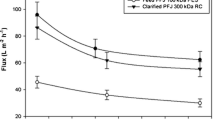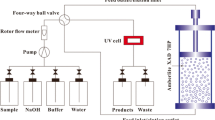Abstract
In an effort to purify potato proteins of superior food grade quality, a new procedure involving anion exchange (ion exchange (IEX)) and hydrophobic interaction chromatography (HIC) was established. Liquid potato fruit juice (PFJ) or re-suspended spray-dried protein was separated by IEX yielding two fractions: a protease inhibitor (PI)-rich fraction and a patatin-rich fraction. Each of these fractions was re-chromatographed on HIC, resulting in two new sub-fractions which were characterised by electrophoresis and mass spectrometry. A high-quality powder should have high lightness, low polyphenol oxidase (PPO) activity and glycoalkaloid content below 150 μg/g. The PI fraction from spray-dried powder had high lightness (L* = 83) compared to patatin (L* = 50), whereas IEX purification from PFJ resulted in a PI fraction with decreased lightness (L* = 66) and a patatin fraction with increased lightness (L* = 68). HIC fractionation led to increased lightness for patatin fraction, but decreased lightness for the PFJ PI fractions. HIC purification significantly lowered PPO activity in the fractions due to its selective affinity. The lowest total glycoalkaloid content was generally found in HIC fractions from spray-dried powder (150 μg/g), while high levels (>1000 μg/g) were found in PI fractions from PFJ. In conclusion, it was possible to obtain a PI-rich protein isolate from powder with good-quality attributes after both IEX and HIC, while for patatin, the best quality was obtained after the HIC only, and there, the colour or PPO activity may still be a problem depending on source material.







Similar content being viewed by others
References
Ali, M., Homann, T., Khalil, M., Kruse, H. P., & Rawel, H. (2013). Milk whey protein modification by coffee-specific phenolics: effect on structural and functional properties. Journal of Agricultural and Food Chemistry, 61(28), 6911–6920.
Alt, V., Steinhof, R., Lotz, M., Ulber, R., Kasper, C., & Scheper, T. (2005). Optimization of glycoalkaloid analysis for use in industrial potato fruit juice downstreaming. Engineering in Life Sciences, 5(6), 562–567.
Alting, A. C., Pouvreau, L., Giuseppin K. L. F., & van Nieuwenhuijzen, N. H. (2011). Potato proteins. In G. O. Phillips, & P. A. Williamn (Eds.), Handbook of food proteins (pp. 316–334). Cambridge: Woodhead Publishing.
Backleh, M., Ekici, P., Leupold, G., Coelhan, M., & Parlar, H. (2004). Enrichment of the glycoalkaloids alpha-solanine and alpha-chaconine from potato juice by adsorptive bubble separation using a pH gradient. Journal of Separation Science, 27(12), 1042–1044.
Barta, J., Hermanova, V., & Divis, J. (2008). Effect of low-molecular additives on precipitation of potato fruit juice proteins under different temperature regimes. Journal of Food Process Engineering, 31(4), 533–547.
Barta, J., Bartova, V., Zdrahal, Z., & Sedo, O. (2012). Cultivar variability of patatin biochemical characteristics: table versus processing potatoes (Solanum tuberosum L.) Journal of Agricultural and Food Chemistry, 60(17), 4369–4378.
Byrne, D. (2002). Commission decision. http://eur-lex.europa.eu/legal-content/EN/TXT/?uri=CELEX%3A32002D0150. Accessed 27 July 2017.
Cheng, T. M., Huang, P. C., Pan, J. P., Lin, K. Y., & Mao, S. J. (2007). Gel electrophoresis of polyphenol oxidase with instant identification by in situ blotting. Journal of Chromatography. B, Analytical Technologies in the Biomedical and Life Sciences, 849(1–2), 331–336.
Duangmal, K., & Apenten, R. K. O. (1999). A comparative study of polyphenoloxidases from taro (Colocasia esculenta) and potato (Solanum tuberosum var. Romano). Food Chemistry, 64(3), 351–359.
Eidhin, D. N., Degn, P., & O’Beirne, D. (2010). Characterization of polyphenol oxidase from rooster potato (Solanum tuberosum cv rooster). Journal of Food Biochemistry, 34(1), 13–30.
He, T., Spelbrink, R. E. J., Witteman, B. J., & Giuseppin, M. L. F. (2013). Digestion kinetics of potato protein isolates in vitro and in vivo. International Journal of Food Sciences and Nutrition, 64(7), 787–793.
Hellenas, K. E., & Branzell, C. (1997). Liquid chromatographic determination of the glycoalkaloids alpha-solanine and alpha-chaconine in potato tubers: NMKL interlaboratory study. Journal of AOAC International, 80(3), 549–554.
Jensen, O. N., Larsen, M. R., & Roepstorff, P. (1998). Mass spectrometric identification and microcharacterization of proteins from electrophoretic gels: strategies and applications. Proteins-Structure Function and Genetics, 74–89.
Jensen, H. B., Poulsen, N. A., Moller, H. S., Stensballe, A., & Larsen, L. B. (2012). Comparative proteomic analysis of casein and whey as prepared by chymosin-induced separation, isoelectric precipitation or ultracentrifugation. Journal of Dairy Research, 79(4), 451–458.
Jorgensen, M., Stensballe, A., & Welinder, K. G. (2011). Extensive post-translational processing of potato tuber storage proteins and vacuolar targeting. The FEBS Journal, 278(21), 4070–4087.
Kamath, P., & Pattabiraman, T. N. (1988). Phenols interfere in protein estimation by the bicinchoninic acid assay-method. Biochemical Archives, 4(1), 17–23.
Knorr, D., Kohler, G. O., & Betschart, A. A. (1977). Potato protein concentrates: the influence of various methods of recovery upon yield, compositional and functional characteristics. Journal of Food Processing and Preservation, 1(3), 235–247.
Laemmli, U. K. (1970). Clevage of structural proteins during assembly of head of bacteriophage-T4. Nature, 227(5259), 680–685.
Lindeboom, N., & Wanasundara, P. (2007). Interference of phenolic compounds in Brassica napus, Brassica rapa and Sinapis alba seed extracts with the Lowry protein assay. Food Chemistry, 104(1), 30–38.
Lokra, S., & Straetkvern, K. O. (2009). Industrial proteins from potato juice. A review. In N. Yee & W. T. Bussell (Eds.), Potato III, Food 3 (Vol. 1, pp. 88–95). New Jersey: Global Science Books.
Lokra, S., Helland, M. H., Claussen, I. C., Straetkvern, K. O., & Egelandsdal, B. (2008). Chemical characterization and functional properties of a potato protein concentrate prepared by large-scale expanded bed adsorption chromatography. LWT-Food Science and Technology, 41(6), 1089–1099.
Marri, C., Frazzoli, A., Hochkoeppler, A., & Poggi, V. (2003). Purification of a polyphenol oxidase isoform from potato (Solanum tuberosum) tubers. Phytochemistry, 63(7), 745–752.
Mattoo, R. L., Ishaq, M., & Saleemuddin, M. (1987). Protein assay by Coomassie brilliant blue G-250-binding method is unsuitable for plant tissues rich in phenols and phenolases. Analytical Biochemistry, 163(2), 376–384.
Narvaez-Cuenca, C. E., Vincken, J. P., & Gruppen, H. (2013). Quantitative fate of chlorogenic acid during enzymatic browning of potato juice. Journal of Agricultural and Food Chemistry, 61(7), 1563–1572.
Partington, J. C., & Bolwell, G. P. (1996). Purification of polyphenol oxidase free of the storage protein patatin from potato tuber. Phytochemistry, 42(6), 1499–1502.
Pots, A. M., Gruppen, H., Hessing, M., van Boekel, M., & Voragen, A. G. J. (1999). Isolation and characterization of patatin isoforms. Journal of Agricultural and Food Chemistry, 47(11), 4587–4592.
Pouvreau, L., Gruppen, H., Piersma, S. R., van den Broek, L. A. M., van Koningsveld, G. A., & Voragen, A. G. J. (2001). Relative abundance and inhibitory distribution of protease inhibitors in potato juice from cv. Elkana. Journal of Agricultural and Food Chemistry, 49(6), 2864–2874.
Prigent, S. V. E., Voragen, A. G. J., Visser, A., van Koningsveld, G. A., & Gruppen, H. (2007). Covalent interactions between proteins and oxidation products of caffeoylquinic acid (chlorogenic acid). Journal of the Science of Food and Agriculture, 87(13), 2502–2510.
Racusen, D. (1989). Patatin purification by hydrophobic interaction chromatography. Journal of Food Biochemistry, 13(6), 453–456.
Ralla, K., Sohling, U., Suck, K., Kasper, C., Ruf, F., & Scheper, T. (2012). Separation of patatins and protease inhibitors from potato fruit juice with clay minerals as cation exchangers. Journal of Separation Science, 35(13), 1596–1602.
Ramírez, E. C., Whitaker, J. R., Virador, V, M. (2003). Polyphenol oxidase. In J. R. Whitaker., A. G. J. Voragen., D. W. S. Wong (Eds.), Handbook of Food Enzymology (pp. 509–537). New York: Marcel Dekker, Inc.
Rawel, H. M., Kroll, J., & Rohn, S. (2001). Reactions of phenolic substances with lysozyme—physicochemical characterisation and proteolytic digestion of the derivatives. Food Chemistry, 72(1), 59–71.
Rawel, H. M., Czajka, D., Rohn, S., & Kroll, J. (2002). Interactions of different phenolic acids and flavonoids with soy proteins. International Journal of Biological Macromolecules, 30(3–4), 137–150.
Schmidt, J. M., Greve-Poulsen, M., Damgaard, H., Hammershoj, M., & Larsen, L. B. (2016). Effect of membrane material on the separation of proteins and polyphenol oxidase in ultrafiltration of potato fruit juice. Food and Bioprocess Technology, 9(5), 822–829.
Schoenbeck, I., Graf, A. M., Leuthold, M., Pastor, A., Beutel, S., & Scheper, T. (2013). Purification of high value proteins from particle containing potato fruit juice via direct capture membrane adsorption chromatography. Journal of Biotechnology, 168(4), 693–700.
Smith, P. K., Krohn, R. I., Hermanson, G. T., Mallia, A. K., Gartner, F. H., Provenzano, M. D., et al. (1985). Measurement of protein using bicinchoninic acid. Analytical Biochemistry, 150(1), 76–85.
Straetkvern, K. O., & Schwarz, J. G. (2012). Recovery of native potato protein comparing expanded bed adsorption and ultrafiltration. Food and Bioprocess Technology, 5(5), 1939–1949.
van Koningsveld, G. A., Gruppen, H., de Jongh, H. H. J., Wijngaards, G., van Boekel, M., Walstra, P., et al. (2001). Effects of pH and heat treatments on the structure and solubility of potato proteins in different preparations. Journal of Agricultural and Food Chemistry, 49(10), 4889–4897.
Zeng, F. K., Liu, H., Ma, P. J., & Liu, G. (2013). Recovery of native protein from potato root water by expanded bed adsorption with Amberlite XAD7HP. Biotechnology and Bioprocess Engineering, 18(5), 981–988.
Acknowledgements
The authors thank the Future Food Innovation (FFI) of region Mid-Jutland, Denmark, KMC (Kartoffelmelcentralen), AKV Langholt (Andelskartoffelmelsfabrikken Vendsyssel) and Aarhus University for financial support of the present work. Furthermore, we thank Ulla Marquardt, laboratory technician at KMC, for analysis of total glycoalkaloids. MALDI-MS and LC-MS/MS analyses were carried out with the support of Proteomics Core Facility under CIISB project (LM2015043) and the project CEITEC 2020 (LQ1601) with financial support from the Ministry of Education, Youth and Sports of the Czech Republic.
Author information
Authors and Affiliations
Corresponding author
Rights and permissions
About this article
Cite this article
Schmidt, J.M., Greve-Poulsen, M., Damgaard, H. et al. A New Two-Step Chromatographic Procedure for Fractionation of Potato Proteins with Potato Fruit Juice and Spray-Dried Protein as Source Materials. Food Bioprocess Technol 10, 1946–1958 (2017). https://doi.org/10.1007/s11947-017-1966-4
Received:
Accepted:
Published:
Issue Date:
DOI: https://doi.org/10.1007/s11947-017-1966-4




